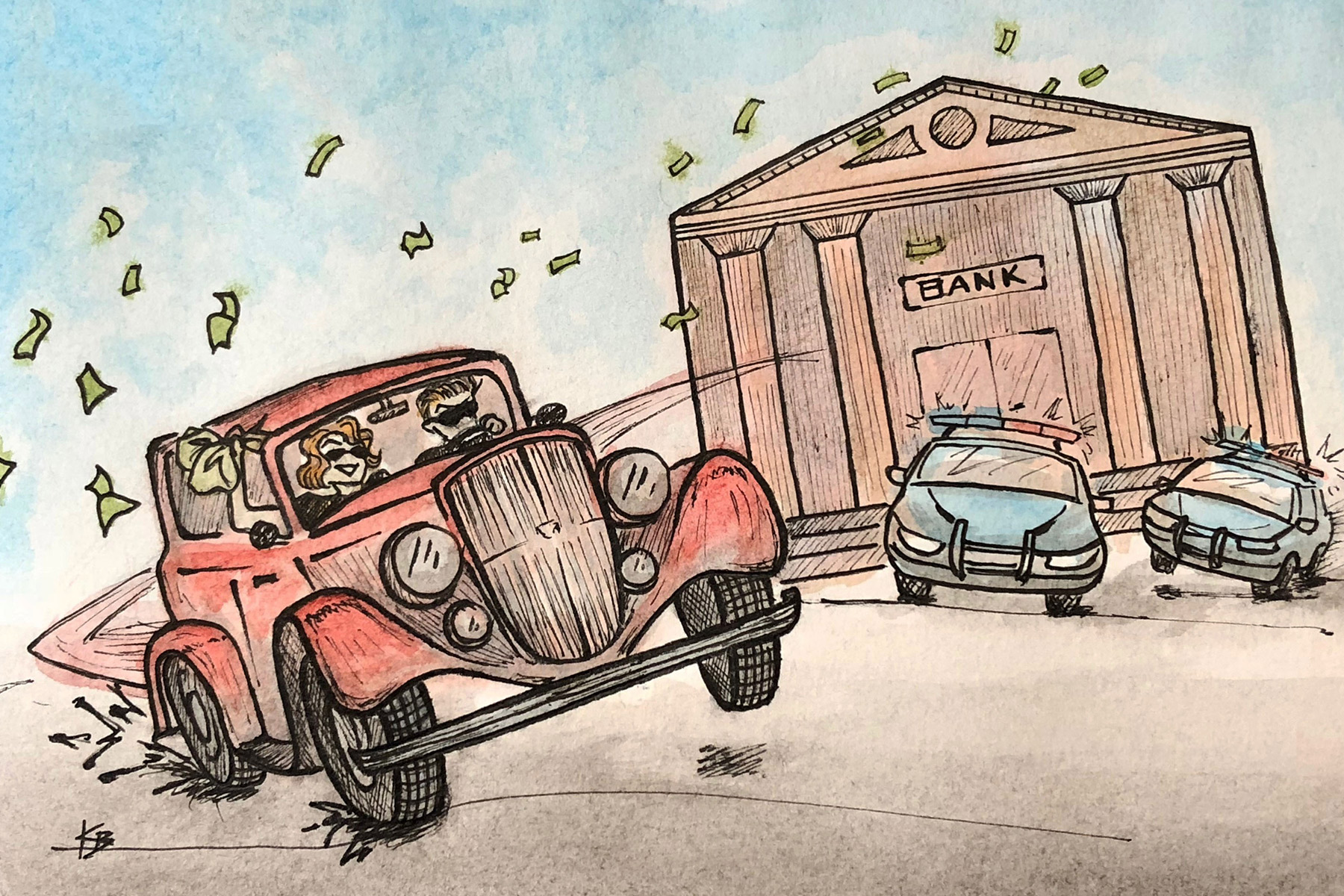Clyde Barrow cut his teeth holding up Dallas banks in the late 1920s and early ’30s, before falling in love and going on the lam with fellow North Texan Bonnie Parker. The couple’s torrid romance made them the nation’s best-known robbers, even though they may have done fewer than 15 jobs in a four-year spree that ended in a 1934 law-enforcement ambush.
Today’s thieves work to reduce their chances of getting caught through tactics like “jugging,” which involves a multi-person crew casing a bank’s entrance to follow and rob people leaving with bags or knapsacks, likely owners of cash-intensive businesses such as check-cashing or convenience stores.
The trend took root in Houston but has spread to North Texas, where people are less familiar with it, according to Melinda Urbina, public affairs officer at the Dallas office of the Federal Bureau of Investigation.
ATMs have also become targets in Dallas, with thieves going so far as to use forklifts on occasion to spirit them way. Criminal groups have flown people in cross-country to teach neighborhood crews in the Lone Star State and beyond how to rob the machines, according to FBI officials in Houston. “We had to adapt to that,” says John Shimp, supervisory special agent at the Houston office.
North Texas bankers say they’ve largely solved the easy part of this puzzle by installing security technology recommended by trade groups and regulators. The hard part is educating staff and customers to help prevent problems. Bank CEOs are less worried about getting the latest gadgets for securing the vault, and more worried about eliminating innocent mistakes that can open doors for criminals, like business owners openly discussing plans for moving cash.
“The weakest link is employees’ attitude about security,” says Robert Hulsey, president and CEO of American National Bank of Texas, a Terrell-based firm with $414 million in assets and a large presence in Dallas and the eastern part of North Texas.
But what concerns the brass at lending institutions more than mere monetary loss is the physical threat to employees and consumers’ safety, according to Scott MacDonald, president and CEO of the Southwestern Graduate School of Banking at SMU’s Cox School of Business in Dallas. “Losing $10,000 is incomparable to someone getting hurt,” he says.
High Risk, Low Returns
Technology and partnerships between law enforcement have resulted in three out of five robberies getting solved, research shows. While Bonnie and Clyde’s biggest score was $1,500 (between $22,674 and $28,258 in modern dollars), hauls from 2017 robberies averaged $3,483, according to the FBI.
So, it may not be surprising fewer than half as many banks (4,761) got robbed nationally last year, versus when the rate of bank robberies peaked in 1991 (9,381), according to data from the FBI and Robert McCrie, a security-management professor at New York’s John Jay College of Criminal Justice.
Statewide, robberies climbed each year from 2014 to 2016, rising from 245 to 301, according to the latest FBI data available. Texas’ share of national robberies grew from 6.3 percent to 7.2 percent over the same period.
Dallas-Fort Worth numbers have ticked down, but the region typically sees 100 to 120 heists each year, according to Dennis May, a 25-year veteran of the FBI who now serves as chief business development officer at Practical Lifesaving Solutions, a security consultancy based in Austin. Back in 1927, when Barrow was learning his trade in Dallas, three to four Texas banks were robbed every day, according to the state historical association.
Crime of the Desperate
The public’s idea of bank robbery may be rooted in the stick-ups of the past. But most thieves don’t use weapons. “Banks can be robbed with nothing more than a sticky note silently passed to a single teller,” says Clay Tumey, a Mesquite native who spent time in prison after doing a string of holdups in 2006, including three in Dallas-Fort Worth. “Hostages aren’t necessary, and violence is just ridiculously uncalled for.”
Tumey and other experts say banks generally instruct tellers to follow criminals’ orders. “They want the robber to leave their institution as quickly as possible, so customers and employees don’t get hurt,” says Tumey, who wrote about his experiences in a 2015 book, The Blue Chip Store. The one-time thief’s criminal career was atypical, as he robbed banks for the rush. Crime was never his primary source of income, he says. “I had a great job at the time as a turbine mechanic.”
May says robbers are typically loners with drug addictions or mental-health issues. Most bank thieves pass notes to tellers, because it lessens their risk of getting injured or killed. Customers often do not realize a robbery has taken place until after the perpetrator leaves.
Many robbers are unarmed because that brings only a two-year sentence if they get caught. Using a gun adds another five years for bank robbery, which became a federal crime in 1934. May tells the story of a Los Angeles suspect who claimed police had shot up his unarmed crew for no reason. “Any fool knows you don’t bring a gun to a bank robbery,” the man told him.
Houston’s Cautionary Tale
Bankers and city leaders might learn lessons from Houston, Texas’ trendsetter in bank-related theft. Houston saw 30 attempts of armored-car robberies between 2013 and 2016, the most in the nation. Experts say this was partly because the region eschews zoning for cash-intensive businesses like banks, meaning they can set up shop most anywhere.
Because of this, underworld types can change up the places they hit, making it harder for law enforcement to figure out where they might go next. Criminals also have more escape routes, because Houston’s freeways are accessible from almost anywhere. “Our highway system offers many exit points for bank robbers,” says Shimp of the Houston FBI. Thus, when considering new bank locations in an area, city planners should take steps to avoid inadvertently aiding thieves in their escapes.
Tumey, for instance, targeted branches that were close both to other businesses, such as a strip center, and busy intersections. “Those facilitated earlier getaways,” he says.
As is common in Houston and elsewhere, criminals often assemble crews of people from particular neighborhoods, specifically to do given jobs, FBI agents say. Members of crews sometimes do not know each other or even the real name of the gang leader behind the heist.
Of the 100 bank robberies in Houston in 2017, 20 of them were “takeover” style, a robbery strategy where multiple crew members brandish guns and sometimes take hostages, Shimp says. Performed by hardened thugs, takeovers aim for bigger scores, as additional robbers can nab cash in more tellers’ drawers and perhaps get into the vault.
Wary of episodes like that, Frisco’s Texas Republic Bank designed its branches to dissuade thieves from attempting robberies, according to David Baty, president and CEO of the 127-year-old institution, which has $238.5 million in assets.
Since robbers prefer tellers to be close to branches’ entrances, Texas Republic designed its facilities make visitors cross a lobby to reach tellers’ booths. To combat casing, Texas Republic’s staff verbally greets customers when they enter the branch. Baty also hires technical consultants to help his security protocols stay abreast of the latest techniques thieves are using. “It’s expensive. We procure services from the top-of-the line service providers,” he says. “We rely on experts to get the best advice.”
Preparing for the Worst
As criminals adopt new methods of pilfering cash from bank locations, lending institutions must decide how much to spend on deterrence. “The financial industry has a tendency to downplay physical security and emphasize more cybersecurity,” says McCrie of John Jay College.
Banks at one time spent less on branch security because they felt it was cheaper to absorb the losses of a few heists, he says. “Security measures might deter commercial activity without adding any measurable benefit,” he says. “If an egregious crime occurs making customers feel unsafe, security will quickly be enhanced at the branch level.”
The Texas Bankers Association says it is looking at assisting in the development of an online reporting network connecting banks with law enforcement.
Jeff Bounds is a freelance business writer in Garland.






